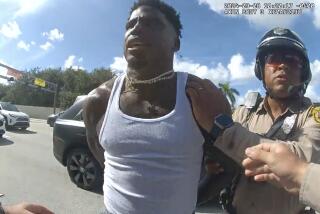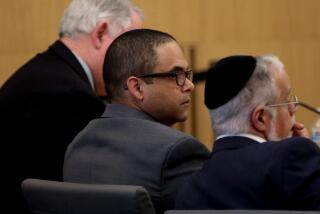Miami Jury Gets Case; City on Edge : Race relations: Many blacks and Latinos take opposite sides in officer’s trial. ‘We are prepared if there is a disturbance,’ the police chief says.
- Share via
MIAMI — An air of hope and apprehension seemed to settle over this city Tuesday night as a six-person jury prepared to consider the fate of a Latino police officer charged with manslaughter in the deaths of two black men last Jan. 16.
With a single shot from his 9mm automatic, Miami Officer William Lozano killed the driver of a motorcycle fleeing a traffic stop, along with his passenger, and touched off three days of rioting in the city’s Overtown section.
The trial began with jury selection Oct. 23 amid mounting tension in this ethnically divided city. Twice before in this decade riots had erupted after a jury had acquitted a white policeman charged in the death of a black.
In this case, many blacks and Latinos have lined up on opposite sides and police have repeatedly warned that they are well prepared for trouble.
“We hope everyone will go home and be peaceful,” Miami Police Chief Perry Anderson said Tuesday. “But we are prepared if there is a disturbance.”
Some observers guessed the jury would need at least two days to go over all the evidence presented during the 12 days of testimony. After listening to Dade Circuit Judge Joseph Farina explain the charges late Tuesday, the jury--which includes two blacks and one Latino--was to begin deliberations at 9 a.m. today.
The question the jurors must answer is whether Lozano, 31, was justified in using deadly force in stopping the motorcycle driven by Clement Lloyd.
Lozano and his partner Dawn Campbell had pulled over on an Overtown street to take a report on a missing license plate decal when Lloyd’s Kawasaki Ninja roared toward him, a police car in pursuit.
The prosecution called several witnesses who testified that Lozano stepped into the street deliberately, pulled his side arm and fired from a two-handed police stance. The slug ripped through Lloyd’s helmet, lodged in the back of his head, and the motorcycle plowed into the front of an oncoming Buick. Lloyd, 23, died instantly. Allan Blanchard, 24, Lloyd’s passenger, died the next day.
Chief prosecutor John Hogan suggested that Lozano may have wanted to stop the motorcycle without firing, but that when Lloyd appeared to ignore him, the officer “out of frustration or contempt . . . takes aim and . . . pulls the trigger.
“In that split second he makes a tragic, horrible mistake,” said Hogan. “It was not in self-defense; it is not excusable.”
Lozano and his defense attorney Roy Black told quite a different tale. Last Thursday Lozano took the stand to swear that he was unaware of the police chase and heard neither the police siren nor the motorcycle when he stepped into the street to get a look at the approaching police car, which he assumed was following someone on foot.
From near the middle of the street, Lozano said, he turned to see the motorcycle was about to hit him. “I was able to turn my body, draw my gun and shot,” said Lozano, who speaks with a heavy Spanish accent. “It was that close. I thought I was going to die.”
Black spent much of Tuesday afternoon painting for the jury a sympathetic picture of Lozano as a gentle, nonviolent man, the father of two children, who came here from his native Colombia at age 13, dropped out of school to work in a factory, but later earned a high school diploma and served in the Army. His wife, Ana, is a Miami policewoman, as are two of his brothers. A third brother is a county corrections officer.
In four years on the Miami police force, Lozano never before had fired his gun, Black said. “This is not a trigger-happy police officer,” said Black.
Hogan and fellow prosecutor Don Horn emphasized Lozano’s comments to police officers on the scene after the shooting that he had known officers were chasing a motorcycle. “There is absolutely no way he didn’t know the chase was coming,” Hogan told the jury. “He had to have heard that motorcycle.”
Early in the day, Black indirectly referred to the tensions surrounding the case, telling the two men and four women on the jury: “This case has nothing to do with racial prejudice. There are people in the community who would make more here than what there really is.”
Efforts to head off violence in connection with the Lozano case have been unprecedented here. Community relations workers, ministers and others have spent weeks talking about the case in various inner city neighborhoods, and both the city and Dade County have set up rumor control hot lines. Attention from the news media has also been intense. All three Miami network affiliates provided live coverage of the closing arguments, which ran from 9 a.m. to almost 6 p.m.
Marvin Dunn, a black sociology professor at Florida International University who wrote a book on the bloody 1980 Miami riot when 18 persons were killed, said Tuesday that he thought the climate in Miami was much improved. He pointed to major differences in the Lozano trial and the two previous police trials. “This is not an all-white jury,” he said. And, he added, he thought Lozano had received “a fair trial, and that Miami is mature enough to accept the results, whatever they may be.”
More to Read
Sign up for Essential California
The most important California stories and recommendations in your inbox every morning.
You may occasionally receive promotional content from the Los Angeles Times.













